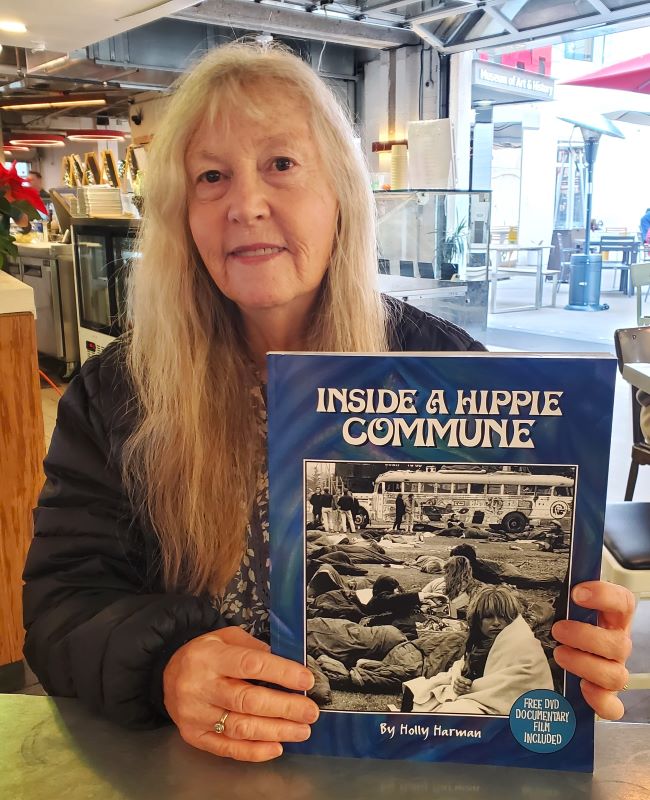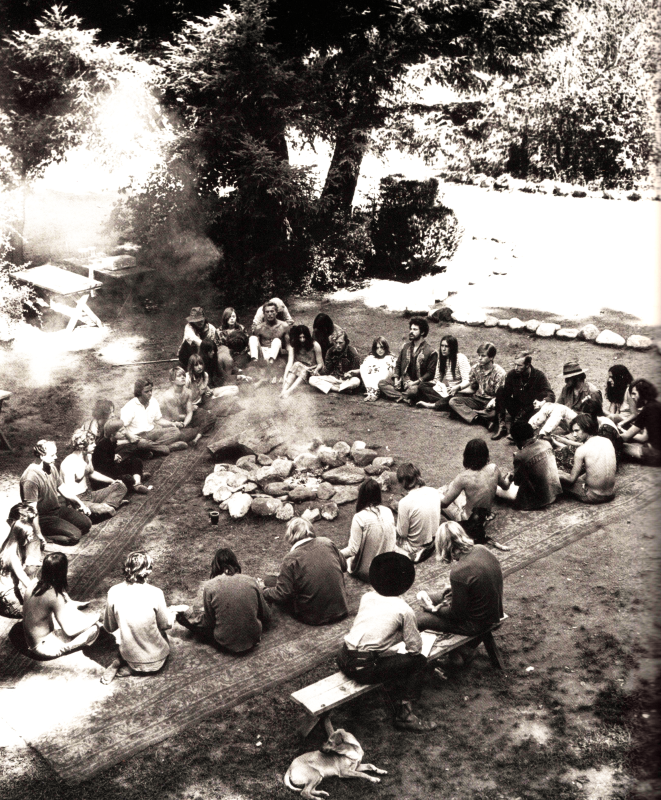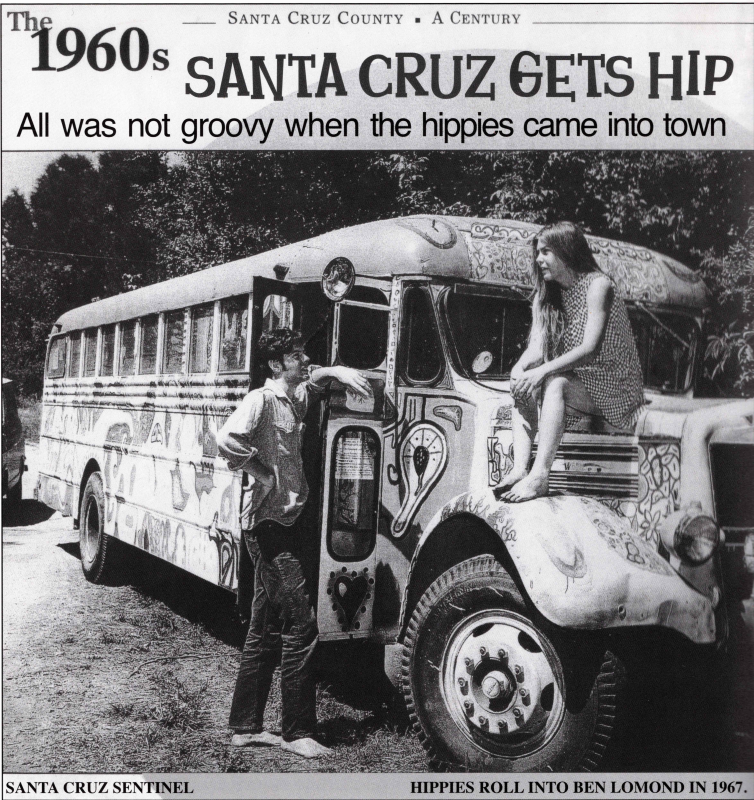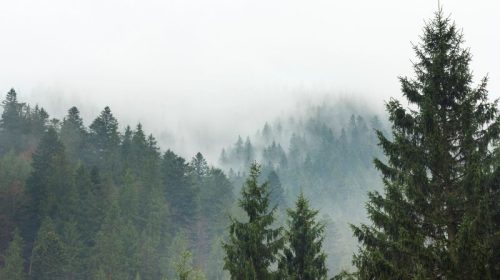Inside a Hippie Commune
Holly Harman’s Tale of 1960s Life at Ben Lomond’s Holidays Cabins
By Mary Andersen
During the tumultuous 1960s, in rural forested settings up and down the West Coast, radical experiments in communal living took root with utopian ideals and countercultural fervor that, for many, still resonate today. Writer Holly Harman was a young teen living with her family in Ben Lomond in the mid-60s. She grew up Inspired by her parents’ Santa Cruz Mountains Bohemian lifestyle, frequenting the Holidays Commune usually on weekends and throughout the summers. In 2012 she published a book, Inside a Hippie Commune, detailing her experiences. Thanks to serendipitous encounters with past members over the years, the book is a trove of original photographs and collected memories. Her recent third printing adds new photos, commentary, and an accompanying DVD with film footage from the era.

Founding members of the commune initially lived in the Boxer Apartments in downtown Ben Lomond but their divergent lifestyle raised the ire of townsfolk worried that these hippies would impact tourism and corrupt young minds. “It was winter, and we had all started to gather inside and hang out and get to know each other. We all got to be close friends,” Holly said. “Well, the townspeople were not happy with us living in town. So in the spring we decided to start looking for a place. And back then there were a lot of river resorts that were abandoned.” They soon found a bucolic location in Ben Lomond with 20 cabins right on the San Lorenzo River. “There’s this beautiful waterfall that’s still there today. And you can get underneath it and the water pours over you.”
While the commune operated as an equitable collective, Ben Lomond residents Gene and Sue Carlson were looked upon as leaders. “Not that they wanted to be, but someone had to be in charge, right?” Holly said. The Carlsons, Harmans, and other original members drew inspiration from the Bridge Mountain Foundation on Alba Road, a holistic retreat center that offered sensory awareness, healing, and transformational workshops. “If you had anything to do with Bridge Mountain, you were called crazy by the people in town at the time. So that when we brought that energy down, it was like, oh no. But they couldn’t keep that influence from coming.” Bridge Mountain Foundation predated Esalen, the more famous of the human potentiality retreats, by a few years having been established around 1957.
Residents at Holidays worked from morning to early afternoon. “Nobody was stagnant,” she said. They adhered to organic farming tenets and tended fruit trees and vegetable gardens before UCSC began experimenting with organic farming and biodiversity and a decade before organic became popularly certifiable in California. Commune members saw themselves as making a break from society by living off the land and reaching for self-sufficiency. “At first, we were going to just keep quiet and do our own thing. They tried to stop us from coming into the grocery stores, but that didn’t last long. The family that ran Roy’s Market in Felton — the Pagninis — would donate supplemental food, which really helped.”

As for art, residents whittled flutes, wove textiles, and created wooden sculptures. Leather sandals were crafted, and an old school bus was painted and collaged.
The county shut the commune down in 1969, citing septic system failure. “While the county was burning down the cabins, someone came in with a big bulldozer and dug a huge, huge hole. So we buried the bus there. It was kind of symbolic,” Holly said.
More than a memoir, Harman paints a vivid picture of the commune’s daily life, from communal meals and music jams to philosophical discussions and psychedelic explorations. Interviews and candid photographs highlight the narrative, conveying readers back in time.
Readers will recognize local scenes and many venues long gone – like the Hip Pocket Bookstore, The Scotts Valley Barn, and more. Throughout, the book skillfully weaves in historical details about the broader hippie movement, the Vietnam War, and the social and political climate of the era, providing a deeper understanding of the commune members’ perspectives.
When asked what her hope was for people who read the book, Holly said, “I’m hoping that somewhere here, there, and everywhere, people will take some of the principles and use them. Drop out, get a piece of land, learn to relax, and maybe use this as a guidebook for a better life with an emphasis on community and friendship.”
Inside a Hippie Commune, 3rd Edition is available at the San Lorenzo Valley Museum in Boulder Creek and at Bookshop Santa Cruz.
Mary Andersen covers culture and politics in the Santa Cruz Mountains. Reach out at mary@slvpost.com.
Featured photo from the book: The Santa Cruz Sentinel registers dismay at counterculture Ben Lomond.
***
Have news or stories to share? The San Lorenzo Valley Post welcomes your Santa Cruz Mountains news, story ideas, photos, and letters. Send us an email.
Sign up for our newsletter to stay connected to news and events in the Santa Cruz Mountains.
Mary Andersen is a journalist and Publisher of the San Lorenzo Valley Post, an independent publication dedicated to the people, politics, environment, and cultures of the Santa Cruz Mountains. Contact mary@slvpost.com





